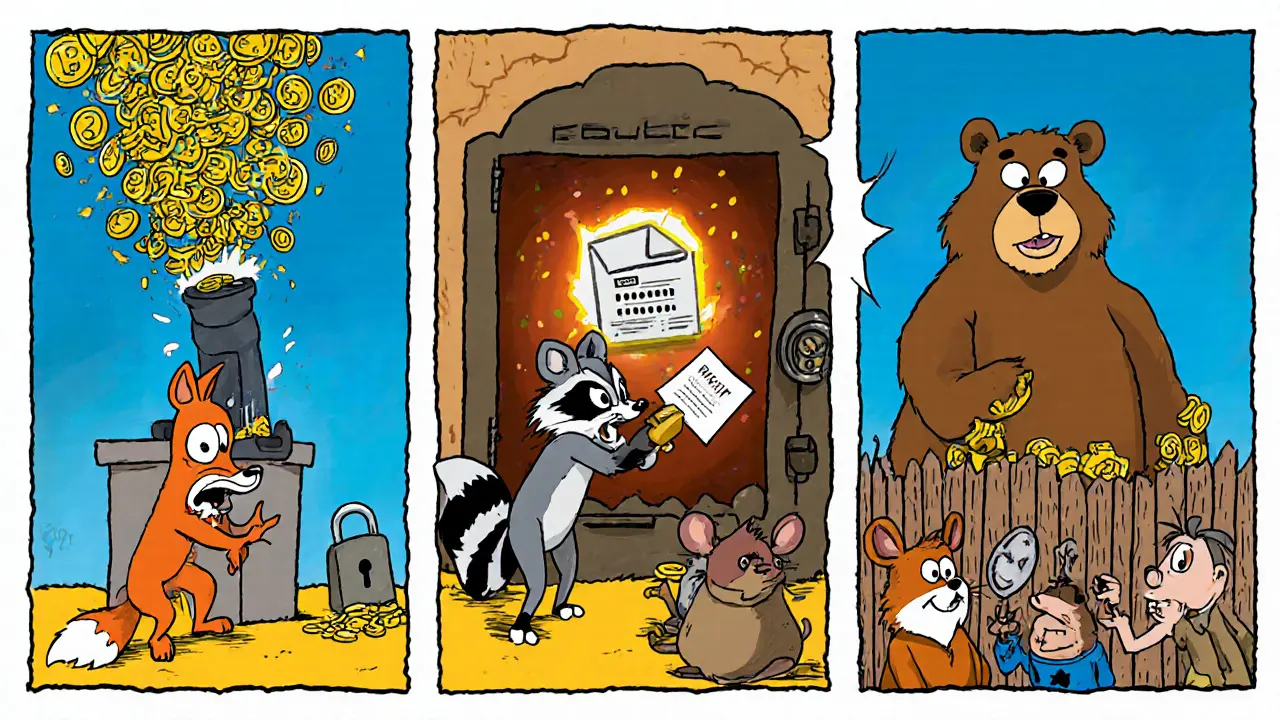
DAO Security Risk Assessment Tool
Attack Vector Analysis
Select which threats your DAO faces to see detailed mitigation strategies.
Flash-loan Exploitation
Attacker borrows massive tokens, votes with >70% power, passes malicious proposal, repays loan in the same block.
Off-chain Voting Manipulation
Proposal disclosed early; attacker buys tokens or front-runs the vote before it's sealed on-chain.
Token-based Coercion
Large holders bribe, threaten, or use influencer campaigns to swing votes.
Security Checklist
Track your progress on implementing key security measures.
Your Security Score: 0%
When a DAO loses millions in a single transaction block, the headline screams DAO security failure. The reality is that most hacks exploit weak governance, not broken code. Below you’ll learn the exact ways attackers strike, the standards emerging to stop them, and a practical checklist you can run on any DAO today.
Key Takeaways
- Flash‑loan voting, off‑chain manipulation, and token coercion are the three biggest threat vectors.
- DAOIP‑8 provides a baseline of mandatory controls, from timelocks to emergency playbooks.
- Lido DAO’s three‑step process (discussion → off‑chain vote → on‑chain execution) dramatically cuts the attack surface.
- Advanced defenses-zero‑knowledge proofs, decentralized identity, and automated smart‑contract guards-are now practical for large DAOs.
- A 10‑point security checklist can lower mean time to respond (MTTR) from days to hours.
What Is a DAO and Why Its Security Matters
A DAO is a blockchain‑based organization that makes decisions through token‑weighted voting instead of a boardroom. Because assets are locked in smart contracts, a successful attack can instantly drain billions without a single gatekeeper to stop it. The economic impact is clear: more than $300million vanished from DAO treasuries between 2022‑2024, shaking investor confidence and slowing adoption.
Top Attack Vectors
Analysis of high‑profile breaches (Beanstalk, Cream Finance, Tornado Cash) reveals a pattern of three core vectors:
| Vector | How It Works | Effective Mitigation |
|---|---|---|
| Flash‑loan exploitation | Attacker borrows massive tokens, votes with >70% power, passes malicious proposal, repays loan in the same block. | Timelocked voting, minimum‑bond requirements, snapshot voting. |
| Off‑chain voting manipulation | Proposal disclosed early; attacker buys tokens or fronts‑runs the vote before it’s sealed on‑chain. | Commit‑reveal schemes, encrypted voting, delayed reveal periods. |
| Token‑based coercion | Large holders bribe, threaten, or use influencer campaigns to swing votes. | Quorum thresholds, diversified voting weight, governance‑mutating audits. |
Each vector attacks the same weak point: the token‑weighted decision engine. If you can limit how quickly voting power shifts, you can block most of these assaults.
Case Studies: What Went Wrong
Beanstalk (April2022) illustrates flash‑loan abuse perfectly. The attacker used a single flash loan to acquire 79% of voting power, submitted a malicious proposal, executed it, and repaid the loan-all within one Ethereum block. The DAO lost $181million, of which $76million stayed locked after hackers returned a portion under community pressure.
Other incidents-Cream Finance, Tornado Cash, and Build Finance-followed similar patterns: weak quorum rules, no timelock, and unrestricted off‑chain voting. In each case, community members spotted suspicious proposals but lacked a coordinated response plan, allowing the attack to complete before anyone could intervene.

DAOIP‑8: The Emerging Security Baseline
The DAOstar organization responded with DAOIP‑8, a set of minimum‑viable controls tailored for decentralized governance. The framework mandates:
- Publicly‑available self‑defense and emergency management plans.
- Mandatory timelocks on any contract upgrade that moves assets.
- Automated simulation of proposals before on‑chain execution.
- Formal audit of every governance‑mutating transaction by qualified contributors.
- Periodic permission audits and multi‑factor authentication for developer accounts.
Implementing DAOIP‑8 alone won’t make a DAO invincible, but it reduces MTTR from days to hours and forces attackers to work against multiple defensive layers.
Governance Design Best Practices
Not all governance models are created equal. Lido DAO’s three‑step process, for example, blends transparency with resilience:
- Discussion phase on a public forum where anyone can raise concerns.
- Off‑chain voting (gas‑free) that aggregates signatures before they hit the chain.
- On‑chain finalization with a 48‑hour timelock, allowing the community to pause if something looks off.
Contrast this with a single‑step on‑chain vote that lets a flash‑loan attacker acquire voting power and push through a proposal in seconds. The extra steps buy time for community review and make front‑running far more expensive.
Other practical rules include:
- Set a minimum quorum of 20% for any fund‑moving proposal.
- Require a “safety committee” of diversified token holders to approve high‑risk changes.
- Enforce a minimum bonding period (e.g., 30days) before newly minted tokens can vote.
Advanced Technical Defenses
Beyond process, cryptography can harden voting itself. Zero‑knowledge proofs (ZK‑SNARKs) let participants prove they voted without revealing their choice, eliminating coercion via bribery or social pressure. Decentralized identity tools-Proof of Humanity, Soulbound Tokens-anchor voting rights to real‑world attributes, reducing Sybil attacks.
Fully off‑chain voting platforms, while still nascent, can provide encrypted commit‑reveal schemes that only publish the final tally on‑chain. The trade‑off is higher infrastructure cost and the need for reliable oracles to feed results back to the DAO.
Smart‑contract‑level guards, such as automated pause functions that trigger on anomalous voting patterns (e.g., sudden >50% power shift within minutes), are gaining traction. ThreatNG Security’s recent SIEM integration can flag such anomalies in real time, sending alerts to the DAO’s emergency channel.
Monitoring, Incident Response, and Community Vigilance
Even the best defenses need eyes on the ground. ThreatNG Security’s monitoring suite watches Web3 domains, tracks unusual transaction spikes, and correlates them with governance events. When a potential flash‑loan attack is detected, the system can automatically invoke the DAO’s emergency pause and broadcast a message to the community chat.
Communities also play a vital role. In the aftermath of the Beanstalk hack, active members posted transaction traces and flagged suspicious voting patterns within minutes, forcing the attackers to return part of the loot. Building a culture of rapid reporting-through Discord bots, GitHub issue templates, or dedicated “security‑watch” channels-shortens the window attackers have to act.
DAO Security Checklist (10‑Point Quick‑Start)
- Adopt DAOIP‑8 baseline controls (timelocks, audit pipeline, emergency playbook).
- Implement a multi‑step governance flow (discussion → off‑chain vote → on‑chain execution).
- Set minimum quorum thresholds and bonding periods for token voting.
- Enable snapshot voting to lock voting power at proposal creation.
- Deploy automated proposal simulation tools (e.g., Tenderly, Hardhat).
- Integrate a real‑time monitoring solution (ThreatNG, OpenZeppelin Defender).
- Define and test an emergency pause procedure for fund‑moving contracts.
- Consider cryptographic voting enhancements (ZK‑proofs, commit‑reveal).
- Run regular permission and MFA audits for developer accounts.
- Educate the community on spotting abnormal voting patterns and reporting channels.
Following this list won’t guarantee zero risk, but it raises the cost of an attack so high that most malicious actors move on to easier targets.

Frequently Asked Questions
What exactly is a flash‑loan attack on a DAO?
A flash‑loan attack borrows a huge amount of tokens for a single transaction, uses that voting power to pass a malicious proposal, then repays the loan-all before the block closes. Because the loan never requires collateral, attackers can momentarily control a majority of votes.
How does DAOIP‑8 differ from traditional security standards?
DAOIP‑8 focuses on governance‑specific risks-timelocks, proposal simulations, and emergency response-whereas classic frameworks (ISO 27001, NIST) address broader IT controls. DAOIP‑8 bridges that gap by mandating controls that protect the decentralized decision engine.
Can off‑chain voting fully prevent flash‑loan attacks?
Off‑chain voting reduces the speed at which voting power can be leveraged, but it’s not a silver bullet. Attackers can still acquire tokens before the off‑chain vote opens, so it should be combined with snapshot mechanisms and minimum bonding periods.
What role do zero‑knowledge proofs play in DAO security?
Zero‑knowledge proofs let voters prove they participated correctly without revealing how they voted. This prevents bribery and coercion because an attacker cannot verify whether a target voted a certain way, making vote‑buying economically unattractive.
How quickly should a DAO respond to a detected attack?
The goal is to react within minutes. DAOIP‑8 recommends an emergency playbook that includes an automated contract pause, an instant community alert, and a rapid‑vote for a rollback. Reducing MTTR from days to minutes dramatically limits losses.

Debby Haime
September 13, 2025 AT 06:59Flash‑loan attacks are wild, but adding a timelock is a cheap way to buy yourself some breathing room. Once the vote is locked for 24‑48 hours you can spot weird power spikes before they execute. I’ve seen projects that missed the window and lost millions in a single block. Pair that with snapshot voting and you cut the attack surface dramatically. Keep the community informed, and the panic button won’t be needed as often.
katie littlewood
September 18, 2025 AT 21:42One thing that really stands out to me is how the checklist bridges theory and practice. By adopting DAOIP‑8 you get a concrete set of controls that feel less like a wish list and more like a battle‑tested framework. The multi‑step governance flow, for instance, not only slows down flash‑loan attackers but also gives ordinary token holders more time to react. I love that the list includes cryptographic voting enhancements – ZK‑proofs are no longer sci‑fi, they’re becoming production‑ready. And the emphasis on real‑time monitoring with tools like ThreatNG ensures that you’re not just setting rules, you’re actively watching for violations. When you combine these layers, you’re basically turning a porous fence into a fortified wall, and that’s exactly the kind of resilience the DAO ecosystem needs right now.
Jenae Lawler
September 24, 2025 AT 12:25It would be naïve to claim that implementing a timelock alone constitutes a comprehensive security posture. The author neglects to address the inherent centralization risk introduced by a small safety committee, which, despite good intentions, may become a de facto authority. Moreover, the reliance on off‑chain voting mechanisms, while superficially elegant, reintroduces a vector for pre‑vote token accumulation that the proposed mitigation does not sufficiently curtail. One must also scrutinize the suggested quorum thresholds; setting them at a mere 20 % may be insufficient given the volatility of token distributions. In short, the recommendations, albeit well‑intentioned, lack the rigor demanded by a truly adversarial environment.
Chad Fraser
September 30, 2025 AT 03:09Love the energy behind the three‑step flow – discussion, off‑chain vote, then on‑chain execution. It feels like a safety net that lets the community sniff out sketchy proposals before they hit the blockchain. If you throw in a quick “pause” button for any proposal that looks funky, you’ve got a solid emergency brake. I’ve helped a few DAOs set up similar pipelines, and the drop‑in loss of confidence from potential attackers is noticeable. Keep the vibe collaborative, and the security posture will follow.
Jayne McCann
October 5, 2025 AT 17:52Sounds like more paperwork, less freedom.
Richard Herman
October 11, 2025 AT 08:35The checklist’s focus on MFA and permission audits is spot on. In my experience, the weakest link is often a developer account that never got two‑factor authentication. Adding regular audits for those accounts makes the whole system harder to compromise. Plus, educating the community about abnormal voting patterns creates a shared sense of vigilance that no technical solution can replace on its own.
Parker Dixon
October 16, 2025 AT 23:19👍 Great rundown! The real‑time monitoring hook is a game‑changer – I’ve seen alerts cut potential exploits in half. Also, don’t forget to add a simple Discord bot that pings the channel when a proposal exceeds a certain voting power threshold. 📢 That way the community can jump in before the flash‑loan attacker even thinks about it.
Stefano Benny
October 22, 2025 AT 14:02From a technical standpoint, the commit‑reveal scheme mitigates front‑running by decoupling vote intention from vote reveal, but it does add latency that may be undesirable for time‑sensitive decisions. Additionally, the suggested quorum of 20 % seems arbitrary; a dynamic quorum that scales with token distribution volatility could provide a more adaptive defense. It would also be worthwhile to integrate a slashing mechanism for proposals that fail post‑execution audits, imposing a financial deterrent on malicious actors.
Bobby Ferew
October 28, 2025 AT 04:45All this talk about checkpoints and audits feels like a lot of busy work that never really stops the real‑world hustle. The attacks keep coming, and the “emergency pause” is just a band‑aid when the real damage is already done. Maybe if we focused on education instead of stacking more layers, we’d see fewer hacks.
celester Johnson
November 2, 2025 AT 19:29One might argue that the pursuit of ever‑more complex governance mechanisms is a manifestation of our collective fear of uncertainty. Yet, by layering cryptographic proofs and multi‑step voting, we paradoxically complicate the very decision‑making process we seek to protect. Is the price of security not also measured in the accessibility we sacrifice? In the end, a DAO that cannot act swiftly may become as vulnerable as one that acts recklessly.
Prince Chaudhary
November 8, 2025 AT 10:12Implementing a minimum bonding period for newly minted tokens adds a simple but effective friction against flash‑loan attacks, without overly burdening honest participants.
John Kinh
November 14, 2025 AT 00:55The checklist is decent, but I’m not convinced it’s worth the overhead – looks like more bureaucracy than security. 🤷♂️
Mark Camden
November 19, 2025 AT 15:39It is incumbent upon every DAO to recognize that security is not an optional afterthought but a foundational pillar. The recommendations outlined herein, while comprehensive, must be rigorously audited, documented, and periodically refreshed to remain effective against an evolving threat landscape.